
|
| Name: _________________________ | Period: ___________________ |
This test consists of 15 multiple choice questions and 5 short answer questions.
Multiple Choice Questions
1. What child's name does Roland G. Fryer, Jr., say would indicate alienation from the black community?
(a) Hunter.
(b) Logan.
(c) Madison.
(d) Madeline.
2. What is the only television show to regularly appear on the top ten watched lists of both black and white viewers?
(a) CBS Evening News.
(b) Saturday Night Live.
(c) Monday Night Football.
(d) The Cosby Show.
3. According to the authors, what does Freakonomics thinking not traffic in?
(a) Policy.
(b) Morality.
(c) False hope.
(d) Product endorsement.
4. How did the Chicago Public School system deal with the confusion of allowing students to choose any school in the city?
(a) They limited choices to a four mile radius.
(b) They had everyone choose a list of ten schools.
(c) They ran a lottery.
(d) They augmented the buildings of the most successful schools.
5. What do the authors try to determine throughout FREAKONOMICS in order to understand people's motivations?
(a) Basic needs.
(b) Belief systems.
(c) Incentives.
(d) Fears.
6. Which group generally tests highest?
(a) Urban students.
(b) There is no data on this topic in the text.
(c) Rural students.
(d) Suburban students.
7. What is the approximate ratio of abortions:murders in America as stated at the end of the chapter?
(a) 1:1.
(b) 50:1.
(c) 100:1.
(d) 75:1.
8. On average, what percentage of the student population is black in a school that an ECLS white child attends?
(a) 20%.
(b) 6%.
(c) 16%.
(d) 13%.
9. According to the authors, what would be a more reasonable educational concern than the black-white achievement gap?
(a) The rural-urban achievement gap.
(b) The white-Hispanic achivement gap.
(c) The good school-bad school gap.
(d) The America-Europe achievement gap.
10. What name did Ms. Bledsoe intend to give her daughter, Temptress?
(a) Septima.
(b) Tamera.
(c) Metress.
(d) Tempestt.
11. Which figure in the book became a Harvard Fellow after doing field research in South Chicago?
(a) Sudhir Venkatesh.
(b) Ronald G. Fryer, Jr.
(c) Stephen Levitt.
(d) Arne Duncan.
12. What term did James Alan Fox use to describe the spike in crime he predicted in the mid 1990s?
(a) Armageddon.
(b) Cataclysm.
(c) Bloodbath.
(d) Free-for-all.
13. Who does Levitt point out has a nearly quadrupled likelihood of dying every year than a death row inmate has of being executed?
(a) A young man in Liberia.
(b) A black child in 1960.
(c) An American serviceman in Iraq.
(d) A Black Gangster Disciple Nation soldier.
14. Who was the hypothetical white boy in the Chapter 5 comparison?
(a) Ted Bundy.
(b) Jeffrey Dahmer.
(c) Timothy McVeigh.
(d) Ted Kaczyniski.
15. In the authors' hypothetical comparison of two boys' lives, where does the poor black boy grow up?
(a) Daytona Beach.
(b) Chicago.
(c) Phoenix.
(d) Bronx.
Short Answer Questions
1. How many names from the top ten most popular black girls names from 1990 do not appear on the 2000 list?
2. According to child-mortality statistics, what is ten times more dangerous than a gun?
3. By how many percentage points did unemployment drop in America drop during the sudden curb of violent crime in the Nineties?
4. What does the ECLS show about the black-white achievement gap for students just entering school?
5. Which of the following factors is revealed not to have a correlative effect on a child's school performance?
|
This section contains 522 words (approx. 2 pages at 300 words per page) |

|




